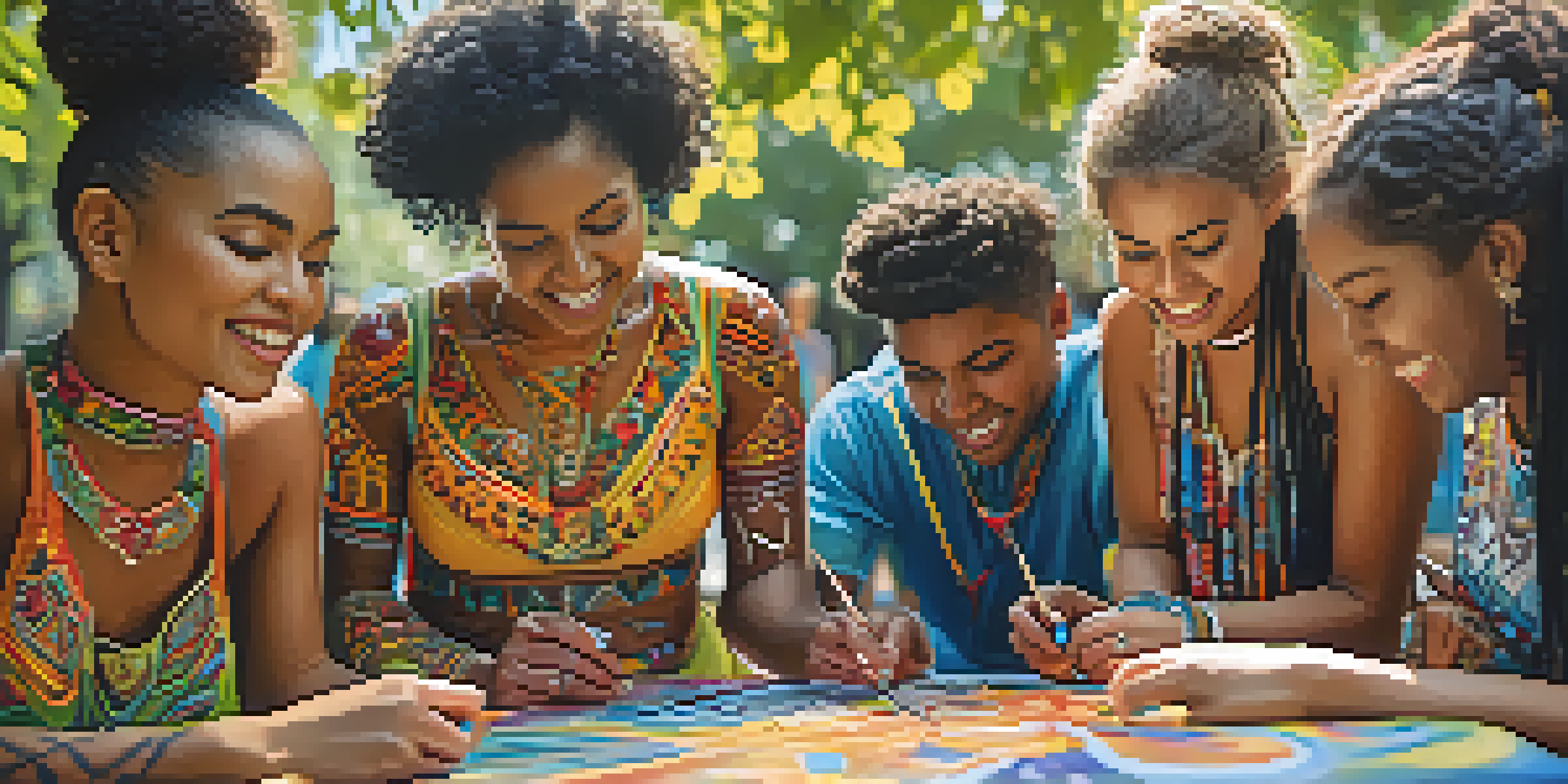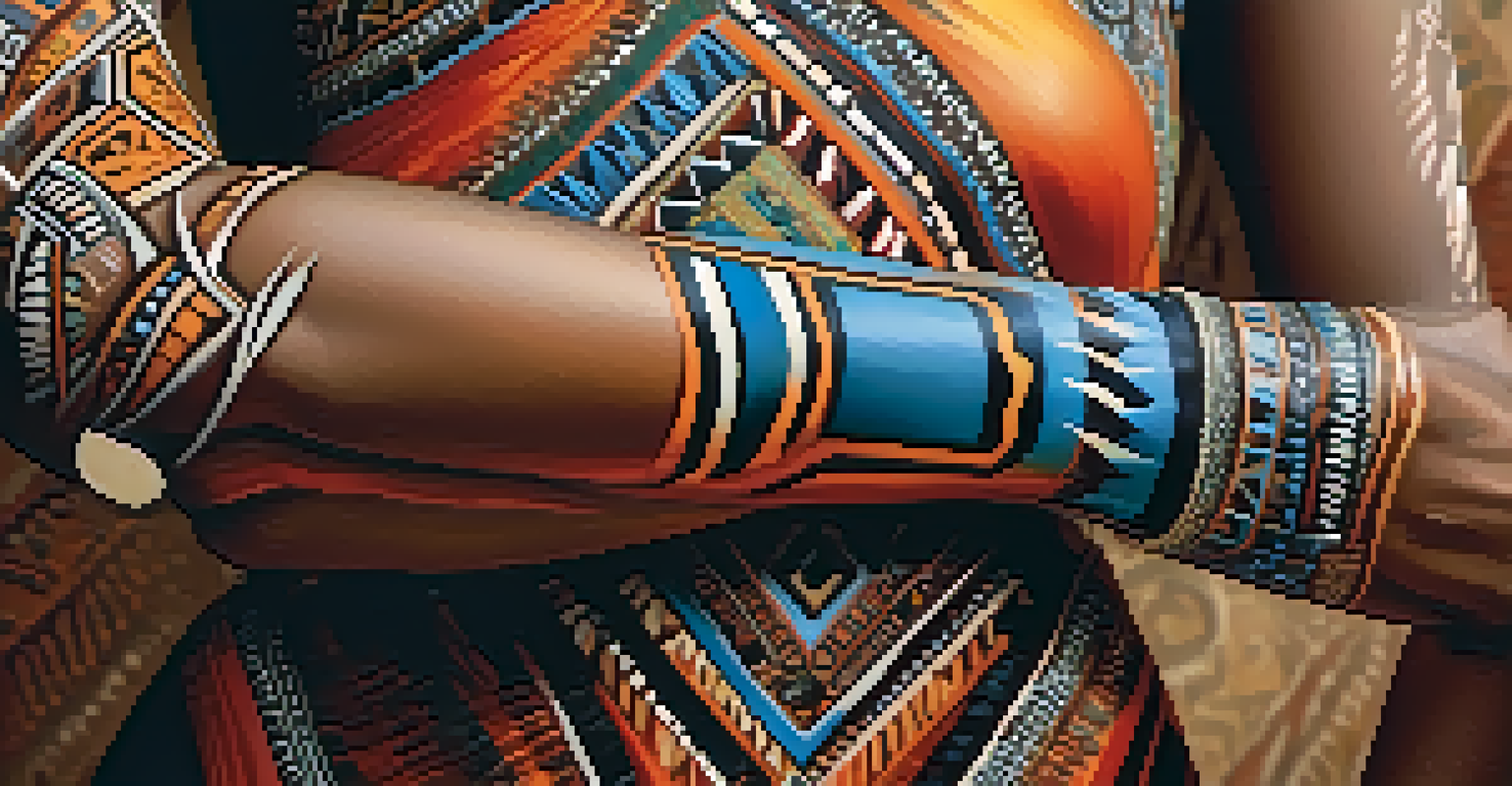The Role of Body Painting in Spiritual and Religious Rituals

Understanding Body Painting in Cultural Contexts
Body painting is an ancient practice found in cultures around the world, often serving as a form of communication and expression. In many societies, it acts as a visual language that conveys cultural stories, beliefs, and identity. When we think of body painting, we often picture vibrant colors and intricate designs, each telling a unique tale that connects individuals to their heritage.
Body painting is a way to communicate our beliefs and identity without uttering a single word.
For instance, Indigenous tribes in the Americas and Africa have used body painting for centuries to signify status, roles, and community belonging. These designs are not just for aesthetics; they represent a deep-rooted connection to their ancestors and spiritual beliefs. By understanding these cultural contexts, we can appreciate the profound significance behind the art of body painting.
Moreover, in today’s globalized world, body painting continues to evolve while retaining its cultural essence. It serves as a bridge between tradition and contemporary art, highlighting how ancient practices can adapt while still honoring their origins. This adaptability speaks to the resilience of cultural expressions in the face of change.
The Spiritual Significance of Body Painting
In many spiritual traditions, body painting is viewed as a sacred act, transforming the human body into a canvas for spiritual expression. For example, in Hinduism, body painting, or 'body art,' often accompanies festivals and rituals, symbolizing divine protection and blessing. The intricate designs and colors used during these ceremonies are believed to invoke the presence of deities, connecting the physical and spiritual realms.

Similarly, among some African tribes, body painting is used during rituals to invoke ancestors’ spirits and seek their guidance. The patterns and colors chosen can vary based on the specific ritual, each carrying its own meaning and purpose. Through these practices, participants often experience a heightened sense of spirituality and connection to their community.
Cultural Significance of Body Painting
Body painting serves as a visual language that conveys cultural stories, beliefs, and identity across various societies.
Additionally, body painting can serve as a tool for personal transformation during spiritual journeys. Many people find that adorning their bodies with paint allows them to express their innermost feelings and beliefs, creating a space for reflection and growth. This practice can be empowering, helping individuals to embrace their identities and spirituality more fully.
Rituals and Ceremonies Featuring Body Painting
Body painting plays a central role in various rituals and ceremonies across different cultures. For example, in the Maori culture of New Zealand, 'ta moko' refers to the traditional tattooing practice that often incorporates body painting. These markings tell stories of the individual’s lineage and achievements, serving as a powerful reminder of their connection to their ancestors during significant life events.
Art is the most beautiful of all lies; it’s a way to reveal the truth of who we are.
Another striking example is the use of body paint in Native American ceremonies, where it symbolizes readiness for battle or spiritual quests. The designs often reflect animals, nature, or symbols that hold personal or cultural meaning. This transformation through body paint prepares individuals both physically and mentally for the challenges ahead, reinforcing their spiritual and communal ties.
Furthermore, body painting is also prevalent in modern spiritual retreats and wellness practices. Many participants engage in body painting as a form of self-exploration and healing during workshops, allowing them to express emotions that words may fail to capture. This contemporary adaptation highlights how body painting remains a vital practice for personal and communal connection.
Body Painting as a Form of Identity Expression
For many, body painting is an intimate form of self-expression that reflects one's identity and beliefs. In various spiritual practices, individuals use body paint to showcase their cultural or personal stories, making their bodies a canvas for self-representation. This act can be liberating, allowing people to reclaim their narratives and express their unique identities in a visually striking way.
Additionally, body painting can serve as a form of resistance against societal norms that dictate how individuals should present themselves. By embracing body art, people challenge conventional ideas of beauty and accept their authenticity. This empowerment through body painting fosters a sense of belonging and community among those who share similar values and beliefs.
Body Painting and Spirituality
In many spiritual traditions, body painting is a sacred act that transforms the body into a canvas for expressing deeper spiritual connections.
Moreover, in the age of social media, body painting has gained popularity as a medium for broader identity exploration. Artists and individuals alike showcase their painted bodies online, creating a dialogue around culture, spirituality, and self-acceptance. This modern twist on body painting illustrates its ongoing relevance in today’s world, bridging the gap between tradition and contemporary expression.
The Therapeutic Benefits of Body Painting
Beyond spiritual and cultural significance, body painting offers therapeutic benefits for many individuals. Engaging in the process of painting one’s body can serve as a form of mindfulness, allowing participants to focus on the present moment and express their emotions creatively. This therapeutic aspect can be particularly beneficial for those dealing with stress, anxiety, or trauma.
In many wellness circles, body painting workshops provide a safe space for participants to explore their feelings and connect with others. The act of applying paint can become a meditative practice, encouraging self-reflection and healing. As individuals immerse themselves in the creative process, they often find a sense of release and empowerment that can be transformative.
Furthermore, body painting can also foster community connections, as participants share their experiences and support one another during the process. This collective experience not only strengthens bonds but also helps individuals feel understood and accepted. The therapeutic benefits of body painting thus extend beyond the individual, creating a ripple effect that nurtures community well-being.
Modern Adaptations of Body Painting in Spiritual Practices
As society evolves, so does the practice of body painting within spiritual contexts. Contemporary artists and practitioners are blending traditional techniques with modern aesthetics, creating innovative forms of body art that resonate with current generations. This evolution not only keeps the practice alive but also allows for new interpretations and expressions of spirituality.
For instance, some spiritual festivals now incorporate body painting as part of their rituals, encouraging participants to express their personal spiritual journeys through art. This adaptation fosters inclusivity, inviting diverse individuals to share their stories and beliefs through body paint. As a result, body painting has become a vibrant, communal experience that celebrates both tradition and modernity.
Therapeutic and Community Benefits
Engaging in body painting offers therapeutic benefits, fostering mindfulness and community connections among participants.
Moreover, workshops and retreats focused on body painting have emerged, attracting those seeking to explore their spirituality through art. These events often emphasize the significance of intention behind body painting, encouraging participants to reflect on their motivations and the messages they wish to convey. This integration of modern practices ensures that body painting remains a relevant and powerful tool for spiritual exploration.
Future Trends in Body Painting and Spirituality
Looking ahead, the future of body painting in spiritual and religious contexts appears promising, with increasing interest in holistic and artistic practices. As more individuals seek to connect with their spirituality in unique ways, body painting is likely to gain traction as a meaningful form of expression. This emerging trend reflects a broader movement towards personalized spirituality that honors individual experiences.
Additionally, advancements in technology may also influence the evolution of body painting. Augmented reality and digital art tools could revolutionize how individuals engage with body painting, allowing for interactive and immersive experiences. This fusion of technology and spirituality could attract a new generation of practitioners eager to explore innovative expressions of their beliefs.

Ultimately, the enduring significance of body painting in spiritual rituals will likely continue to inspire and connect people across cultures. As traditions adapt and modernize, body painting will remain a powerful medium through which individuals can articulate their spirituality, identity, and sense of belonging in an ever-changing world.